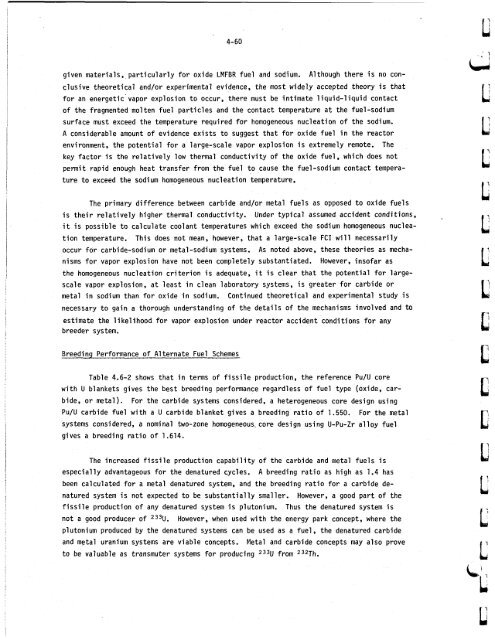ORNL-5388 - the Molten Salt Energy Technologies Web Site
ORNL-5388 - the Molten Salt Energy Technologies Web Site
ORNL-5388 - the Molten Salt Energy Technologies Web Site
Create successful ePaper yourself
Turn your PDF publications into a flip-book with our unique Google optimized e-Paper software.
4-60<br />
given materials, particularly for oxide LMFBR fuel and sodium. Although <strong>the</strong>re is no con-<br />
clusive <strong>the</strong>oretical and/or experimental evidence, <strong>the</strong> most widely accepted <strong>the</strong>ory is that<br />
for an energetic'vapor explosion to occur, <strong>the</strong>re must be intimate liquid-liquid contact<br />
of <strong>the</strong> fragmented molten fuel particles and <strong>the</strong> contact temperature at <strong>the</strong> fuel-sodium<br />
surface must exceed <strong>the</strong> temperature required for homogeneous nucleation of <strong>the</strong> sodium.<br />
A considerable amount of evidence exists to suggest that for oxide fuel in <strong>the</strong> reactor<br />
environment, <strong>the</strong> potential for a large-scale vapor explosion is extremely remote. The<br />
key factor is <strong>the</strong> relatively low <strong>the</strong>rmal conductivity of <strong>the</strong> oxide fuel, which does not<br />
permit rapid enough heat transfer from <strong>the</strong> fuel to cause <strong>the</strong> fuel-sodium contact tempera-<br />
ture to exceed <strong>the</strong> sodi um homogeneous nucleation temperature,<br />
The primary difference between carbide and/or metal fuels as opposed to oxide fuels<br />
is <strong>the</strong>ir relatively higher <strong>the</strong>rmal conductivity. Under typical assumed accident conditions,<br />
it is possible to calculate coolant temperatures which exceed <strong>the</strong> sodium homogeneous nucleation<br />
temperature. This does not mean, however, that a large-scale FCI will necessarily<br />
occur for carbide-sodium or metal-sodium systems. As noted above, <strong>the</strong>se <strong>the</strong>ories as mechanisms<br />
for vapor explosion have not been completely substantiated. However, insofar as<br />
<strong>the</strong> homogeneous nucleation criterion is adequate, it is clear that <strong>the</strong> potential for largescale<br />
vapor explosion, at least in clean laboratory systems, is greater for carbide or<br />
metal in sodium than for oxide in sodium. Continued <strong>the</strong>oretical and experimental study is<br />
necessary to gain a thorough understanding of <strong>the</strong> details of <strong>the</strong> mechanisms involved and to<br />
estimate <strong>the</strong> likelihood for vapor explosion under reactor accident conditions for any<br />
breeder system.<br />
Breeding Performance of Alternate Fuel Schemes<br />
Table 4.6-2 shows that in terms of fissile production, <strong>the</strong> reference Pu/U core<br />
with U blankets gives <strong>the</strong> best breeding performance regardless of fuel type (oxide, carbide,<br />
or metal). For <strong>the</strong> carbide systems considered, a heterogeneous core design using<br />
Pu/U carbide fuel with a U carbide blanket gives a breeding ratio of 1.550. For <strong>the</strong> metal<br />
systems considered, a nominal two-zone homogeneous. core design using U-Pu-Zr alloy fuel<br />
gives a breeding ratio of 1.614.<br />
The increased fissile production capability of <strong>the</strong> carbide and metal fuels is<br />
especially advantageous for <strong>the</strong> denatured cycles. A breeding ratio as high as 1.4 has<br />
been calculated for a metal denatured system, and <strong>the</strong> breeding ratio for a carbide de-<br />
natured system is not expected to be substantially smaller. However, a good part of <strong>the</strong><br />
fissile production of any denatured system is plutonium. Thus <strong>the</strong> denatured system is<br />
not a good producer of 233U. However, when used with <strong>the</strong> energy park concept, where <strong>the</strong><br />
plutonium produced by <strong>the</strong> denatured systems can be used as a fuel, <strong>the</strong> denatured carbide<br />
and metal uranium systems are viable concepts. Metal and carbide concepts may also prove<br />
to be valuable as transmuter systems for producing 233U from 232Th.<br />
I<br />
- 1<br />
t:<br />
L<br />
I:<br />
L'<br />
I:



![Review of Molten Salt Reactor Physics Calculations [Disc 2]](https://img.yumpu.com/21979492/1/190x247/review-of-molten-salt-reactor-physics-calculations-disc-2.jpg?quality=85)












